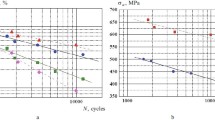Abstract
Effects of strain rate and strain wave shape on high temperature low cycle fatigue life of cast IN 738 nickel-base superalloy were investigated at 1123 K. Intergranular crack initiation and mixed crack propagation were observed mainly in slow-fast saw tooth wave, slow-slow triangular wave, and in truncated wave with hold time in tension and in both tension and compression tests. A reduction in the fatigue life of the specimens tested under these wave shapes, compared to those under fast-fast type of triangular wave shape, corresponded with a variation in the fracture mode. On the basis of a defined crack initiation criterion the test results were analyzed by the strain range partitioning method proposed by Manson, Halford, and Hirschberg. The observation that the wave shape effect on life was very sensitive when examined from the elastic strain range viewpoint suggested that a life prediction method that involves stresses may also be worthy of consideration.
Similar content being viewed by others
References
ASME Boiler and Pressure Vessel Code, Case N-47, ASME, New-York, NY, 1981.
U. S. Lindholm and D. L. Davidson:Fatigue at Elevated Temperature, ASTM STP 520, p. 473, 1973.
D. C. Lord and L. F. Coffin, Jr.:Metall. Trans., 1973, vol. 4, pp. 1647–54.
W. J. Ostergren:J. Testing Evaluation, 1976, vol. 4, pp. 327–39.
S. D. Antolovich, S. Lin, and R. Baur:Metall. Trans. A, 1981, vol. 12A, pp. 473–81.
S. D. Antolovich, E. Rosa, and A. Pineau:Mat. Science and Engineering, 1981, vol. 47, pp. 47–57.
M. Y. Nazmy:Mat. Science and Engineering, 1982, vol. 55, pp. 231–37.
S. D. Antolovich, P. Domas, and J. L. Strudel:Metall. Trans. A, 1979, vol. 10A, pp. 1859–68.
C. J. McMahon and L. F. Coffin, Jr.:Metall. Trans., 1970, vol. 1, pp. 3443–50.
L. F. Coffin, Jr.:Fatigue At Elevated Temperature, ASTM STP 520, 1973, p. 5.
L. F. Coffin, Jr.:Metall. Trans., 1974, vol. 5, pp. 1053–60.
C. S. Kortovich and A. A. Sheinker: Proc. AGARD Conf. “The Characterization of Low Cycle High Temperature Fatigue by the Strain Range Partitioning Method,” Conf. Proc. 243, Advisory Group for Aeronautical Research and Development, North Atlantic Treaty Organization, 1978, p. 1.
S. S. Manson:Fatigue At Elevated Temperature, ASTM STP 520, 1973, p. 744.
L. F. Coffin, Jr.Proc. 4th Int. Conf. on Fracture, Fracture 1977, D. M. R. Taplin, ed., University of Waterloo, Canada, 1977, vol. 1, pp. 263–92.
S. Majumdar and P. S. Maiya:Proc. ASME-MPC Symposium on Creep-Fatigue Interaction, R. M. Curran, ed., MPC-3, ASME, New York, NY, 1976, p. 323.
J. L. Chaboche:Nuclear Engineering and Design.1981, vol. 64, pp. 233–47.
S. S. Manson, G. R. Halford, and M. H. Hirschberg: NASA TMX-67838, 1971.
G. R. Halford, M. H. Hirschberg, and S. S. Manson:Fatigue at Elevated Temperature, ASTM STP 520, 1973, p. 658.
S. S. Manson: Proc. AGARD Conf. “The Characterization of Low Cycle High Temperature Fatigue by the Strain Range Partitioning Method“, Conf. Proc. 243, 1978, p. k.
G. R. Halford and A. J. Nachtigall: Proc. AGARD Conf. “The Characterization of Low Cycle High Temperature Fatigue by the Strain Range Partitioning Method,” Conf. Proc. 234, 1978, p. 2.
R. A. Stevens and P. E. J. Flewitt:Acta Met.,1981, vol. 29, pp. 867–82.
R. B. Scarlin:Proc. 4th Int. Conf. on Fracture, Fracture 1977, D. M. R. Taplin, ed., University of Waterloo, Canada, 1977, vol. 2, pp. 849–57.
G. R. Halford: Proc. AGARD Conf. “The Characterization of Low Cycle High Temperature Fatigue by the Strain Range Partitioning Method“, Conf. Proc. 243, 1978, p. D4-6.
J. H. Underwood and J. F. Throop:Part-Through Crack Fatigue Life Prediction, ASTM STP 687, 1977, p. 195.
A. Witt, R. König, and C. Eckard: Final report on “Niedrigwechsel-festigkeit von Gasturbinenwerkstoffen“, Klöckner-Humboldt-Deutz AG, Oberursel, W. Germany, 1980.
S. Yoshida, K. Kanazawa, K. Yamaguchi, M. Sasaki, K. Kobayashi, and M. Sato:Trans. NRIM, 1977, vol. 19, pp. 247–72.
K. Yamaguchi and K. Kanazawa:Metall. Trans. A, 1980, vol. 11A, pp. 2019–27.
M. F. Day and G. B. Thomas: Proc. AGARD Conf. “The Characterization of Low Cycle High Temperature Fatigue by the Strain Range Partitioning Method”, Conf. Proc. 243, 1978, p. 10.
W. Hoffelner and C. Wüthrich: Brown Boveri Research Center Report KLR 32C, Baden, Switzerland, 1981.
M. Y. Nazmy:Fatigue of Engineering Materials and Structures, 1981, vol. 4, pp. 253–61.
Author information
Authors and Affiliations
Rights and permissions
About this article
Cite this article
Nazmy, M.Y. High Temperature Low Cycle Fatigue of IN 738 and Application of Strain Range Partitioning. Metall Trans A 14, 449–461 (1983). https://doi.org/10.1007/BF02644222
Received:
Issue Date:
DOI: https://doi.org/10.1007/BF02644222




